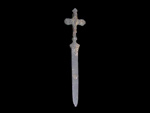 |
Artifact No.1 |
© David Xavier Kenney 2005 |
|
| |
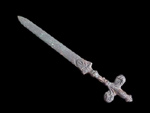 |
Artifact No.1 |
© David Xavier Kenney 2005 |
|
| |
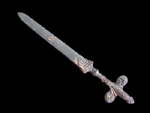 |
Artifact No.1 |
© David Xavier Kenney 2005 |
|
| |
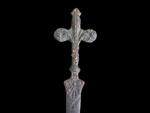 |
Artifact No.1 |
© David Xavier Kenney 2005 |
|
| |
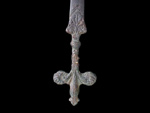 |
Artifact No.1 |
© David Xavier Kenney 2005 |
|
| |
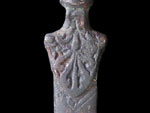 |
Artifact No.1 |
© David Xavier Kenney 2005 |
|
| |
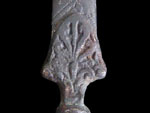 |
Artifact No.1 |
© David Xavier Kenney 2005 |
|
| |
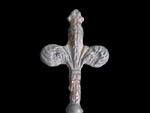 |
Artifact No.1 |
© David Xavier Kenney 2005 |
|
| |
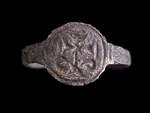 |
Artifact No.2 |
© David Xavier Kenney 2005 |
|
| |
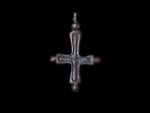 |
Artifacts No.3-1 |
© David Xavier Kenney 2005 |
|
| |
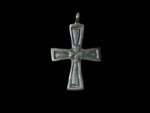 |
Artifacts No.3-2 |
© David Xavier Kenney 2005 |
|
| |
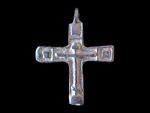 |
Artifact No.4 |
© David Xavier Kenney 2005 |
|
| |
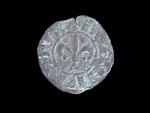 |
Artifact No.5 |
© David Xavier Kenney 2005 |
|
| |
|
MEDIEVAL FRENCH OR NORMAN MINIATURE SWORD PUNCH DAGGER
This as ARTIFACT # 1 is a Medieval French or Norman miniature silver sword punch dagger that has traces of gold gilt circa 12th to 14th c AD. There is a small amount of rust, which suggests that there is an iron or steel tang and spike under the silver. Of course the only way to verify this would be to x-ray the dagger. The dagger is 16 cm in length and 3 ½ cm at its widest part. The blade’s edges are blunt. The traces of gilding can be seen only on the handle. The dagger is balanced where the shield guard meets the handle. It is also amply balanced for throwing. Although this dagger could have been made for novelty, it very likely was designed to be used as a small punch dagger. The size of the hand holding the dagger does not seem to affect its grip, so it could have been used as a weapon by a man, boy or a woman. Speculation is that this may have been a sleeve dagger. The pommel and handle is not like anything that I have seen. The blade resembles a 10th c AD Viking/Norman blade style but it could also resemble sword blades made much earlier. The shield on the guard should be associated with Medieval nobility. Some of the art motifs on the shield are similar to what can be seen from the Dark Ages, but the art style on the handle appears to be from a period after the 11th c AD.
The handle is most unique, and combined with the pommel appears as a fleur-de-lis. In my opinion this type of fleur-de-lis is typically seen after the Normans enter France. It is also my opinion that this type of fleur-de-lis symbolizes a ram’s head and horns. This fleur-de-lis punch dagger finger grip could have several different meanings. First, it could represent a Latin cross. Besides the fleur-de-lis, there are curling leaves or waves. Inside each of these curls there is a feather. On one side beside one of the feather’s tips, there is a flower, on the other there is what appears to be a grape motif. On the other side of the dagger with the same feather motif, there is a flower on one side and a honeycomb design on the other. The overall design of this handle finger grip could also be associated with maize, as the top part of the handle looks much like an ear of corn with a tassel. If this is so, it would have to have been made after the end of the 15th century, or was the maize of the New World known before Columbus's discovery of America? The handle also resembles a knight’s helmet with a feather crest, with the handle’s finger grips representing his shoulders. Another view of just the finger grip could be viewed as a ram’s head and horns. My assessment is that this design is of a pagan god associated with the air, the sea, and the ram, also possibly with the vine and bees. On the shield there is a bearded face and a centered spear or lance. The beard is made to appear as waves, similar to some ancient art depiction's of Poseidon or Neptune. Under this shield on the blade is an engraved chevron, which was a Medieval symbol of noble service but not necessarily military service. Turned upside down the shield appears as a helmet, but particularly as a domed ancient Celtic Gaulish type helmet. The helmet pictured appears to hold a center oval object such as a gem or stone which is emitting flames. My speculation is that this punch dagger is a Medieval fantasy depiction of the sword of Manannan mac Lir, named Fragarach (The Answerer or The Retaliator, or The Sword of Air). Manannan gave this sword to the god Lugh Lamfada (his stepson) and later Lugh gave it to Conn of the Hundred Battles. This sword was one of the four gifts presented to the four legendary cities of the Tuatha De Danann, when that race settled in Ireland. It was supposed to be able to penetrate all armor and to command the wind. The other three gifts that the Tuatha De Danann brought with them to Ireland were Lia Fail (the king-making Stone of Destiny), Gae Assail (a magical lightning spear), and the Cauldron of Dagda (a magical feeding cauldron). These symbols could all be depicted possibly on this dagger, as the shield can also be seen as a cauldron and the helmet device as a stone, along with the spear on the shield face. The Celtic Irish god Manannan mac Lir (his Welsh equivalent is Manawydan) is of the Tuatha De Danann and a protector magician warrior god of the sea, air, fertility, and weather. His domain is the sea, various mythical otherworld islands including Emain Ablach” land of apples, a land of youth similar to the Isle of Avalone” which was either an island or at the bottom of the sea. He has a cloak of invisibility (the shoulder leaves or waves on the dagger’s finger grip?) that may be associated with a cloak of protective mist, a flaming helmet, and sometimes the sword Fragarach. He also has a chariot and a horse (or horses) which can travel over water and he has a ship that was self-propelled. He was married to the goddess Fand who left him for Cuchulainn, but he also had other goddesses as wives or lovers. As a magician, he could create an illusion against enemies by turning sea shells into ships. It is also thought that he created the mist that the Tuatha De Dannan arrived on when they entered Ireland. Manannan’s name is most likely a nickname; is so then his real name is not known. He was Guardian of the Blessed Islands (Islands of Youth and Plenty), which some believe to be an island of apples (Avalone). The Isle of Man is named after him. His sacred bird is the heron (feathers on the dagger’s finger grip?).
There is another god which may or may not be associated with this dagger. This god is Heimdall, who is the Norse Guardian god of the Bifrost bridge and who is also associated with the sea. Heimdall is a youthful god who some believe originated from the Celtic god Manannan mac Lir. He is highly associated with the Norse rune Mannaz which sounds very close to Manannan. Just like Manannan his name was most likely a nickname. Heimdall carries the horn Gjallar and one of his names, Hallinskidi, is thought to mean “Ram.” His sword and possibly his armor are named Hofund (Ram’s head). He is the son of the god Odin, who fathered him by sleeping with nine sisters who were either water nymphs or giantesses. He is associated with white (due to his white armor) and gold (his teeth are gold); but he is also associated with the color red. He is a founding god credited with the fathering of three sons, which established the three classes of the Norse. Guarding the entrance to Asgard, he is the ultimate guard as he has exceptional sight and hearing even for a god. Heimdall will sound the beginning of the battle of Ragnok (Norse final battle of the gods) and will kill and be killed by the evil god Loki. It is thought that Bifrost Bridge is the Milky Way and that Heimdall stands guard somewhere nearby. This god may very well be associated with the star/constellation of Arcturus (Bootes), which is also associated with guarding (Arcturus the Bear Guard) and is in fact in the thick disk of the Milky Way galaxy. If the dagger is connected to this Norse god, then the handle may very well have a streamlined shape similar to the constellation/star of Arcturus. The connection between Manannan and Heimdall is quite obvious. If this Medieval miniature punch dagger depicts the Celtic Irish god Manannan mac Lir, then there is also an Arthurian connection. Manannan’s sword Fragarach may also have been an inspiration for the swords of Arthurian legend. Particularly that written about by Geoffrey of Monmouth, Wace, and Layamon, the “Caliburnus” in Latin (Calburn in English) which had been forged on the Isle of Avalon. This dagger may actually be a Medieval artist’s conception of the sword Caliburn, which would later be given the French name Excalibur (cut steel) by other Arthurian writers. For comparison I have included a picture of a 12th to 13th c bronze French Norman chalice ring as ARTIFACT # 2. This ring shows on the bezel a cross that also resembles a chalice with a bowtie shape perpendicular to its stem. In the center of the bow is an “x” below the fleur-type ram’s horns. The bow may represent a bear’s eyes on either side of the “x", it may also be of the Norse rune Mannez. These may be symbolic of two stars belonging to the constellation/star Arcturus. The fleur-type ram’s horns could also represent two other stars which are in different positions, of that constellation. I have also included pictures of two French Norman (possibly Saxon)bronze bear head Latin crosses that may possibly have been used by the Crusaders as ARTIFACTS # 3-1 and # 3-2 (these may also be of the Norse rune Mannez and are of the same era as the Artifact # 2 ring). Next is a Kievan Rus Orthodox bronze bear headed cross that is distinctly of St. Olga and of the same era as the other rings listed here. This first saint of the Rus St. Olga was the wife of Igor the Grand Prince (or Grand Duke) of Kiev and Russia. Igor was the son of Rurik the semi legendary Varangian (Eastern Viking) founder of Kiev. St. Olga is thought to have been a Varangian. She was the first Christian regent of the Kievan Rus ruling from 945 to 964 AD. This cross is listed as ARTIFACT # 4 Lastly, I have included a picture of a Crusader States Antioch coin of Bohemund IV (1201-1216). This shows the ram’s-head type fleur-de-lis with four pellets as ARTIFACT # 5.
Copyright 2005 David Xavier Kenney
Posted on 29-NOV-05
|

